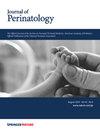利用人工智能预测早产儿肺出血。
IF 2.4
3区 医学
Q2 OBSTETRICS & GYNECOLOGY
引用次数: 0
摘要
目的:确定与早产儿肺出血相关的临床变量和指标。方法:本病例对照研究纳入新生儿。结果:在1133例筛查婴儿中,35例有出血。平均胎龄25.6±1.6周,出生体重753±224 g,中位起出血时间为44.5 h。受影响的婴儿通常需要胸部按压和有创通气。机器学习(准确率为83%,AUC为90%)发现,在生命最初12小时内重复使用表面活性剂和产后低血压是最重要的预测因素,此外还有产妇和胎龄。病例死亡率高于对照组(19% vs. 3%, p = 0.005)。结论:重复给药及产后早期低血压是早产婴儿肺出血的重要预测因素。本文章由计算机程序翻译,如有差异,请以英文原文为准。

Leveraging artificial intelligence for prediction of pulmonary hemorrhage in preterm infants
To identify clinical variables and indicators associated with pulmonary hemorrhage in preterm infants. This case-control study included inborn infants <32 weeks. Data were collected in 12-h epochs from birth until hemorrhage onset or up to 72 h for controls. Machine learning used the Random Forest algorithm. Statistical analysis included T test and Mann–Whitney U test. Among 1133 screened infants, 35 had hemorrhage. Mean gestational age was 25.6 ± 1.6 weeks, birth weight 753 ± 224 g, and median onset of hemorrhage was 44.5 h. Affected infants more often required chest compressions and invasive ventilation. Machine learning (accuracy = 83%, AUC = 90%) identified repeated surfactant dosing and postnatal hypotension in the first 12 h of life as top predictors, along with maternal and gestational age. Mortality was higher in cases than controls (19% vs. 3%, p = 0.005). Repeated surfactant dosing and early postnatal hypotension are key predictors for pulmonary hemorrhage in preterm infants.
求助全文
通过发布文献求助,成功后即可免费获取论文全文。
去求助
来源期刊

Journal of Perinatology
医学-妇产科学
CiteScore
5.40
自引率
6.90%
发文量
284
审稿时长
3-8 weeks
期刊介绍:
The Journal of Perinatology provides members of the perinatal/neonatal healthcare team with original information pertinent to improving maternal/fetal and neonatal care. We publish peer-reviewed clinical research articles, state-of-the art reviews, comments, quality improvement reports, and letters to the editor. Articles published in the Journal of Perinatology embrace the full scope of the specialty, including clinical, professional, political, administrative and educational aspects. The Journal also explores legal and ethical issues, neonatal technology and product development.
The Journal’s audience includes all those that participate in perinatal/neonatal care, including, but not limited to neonatologists, perinatologists, perinatal epidemiologists, pediatricians and pediatric subspecialists, surgeons, neonatal and perinatal nurses, respiratory therapists, pharmacists, social workers, dieticians, speech and hearing experts, other allied health professionals, as well as subspecialists who participate in patient care including radiologists, laboratory medicine and pathologists.
 求助内容:
求助内容: 应助结果提醒方式:
应助结果提醒方式:


